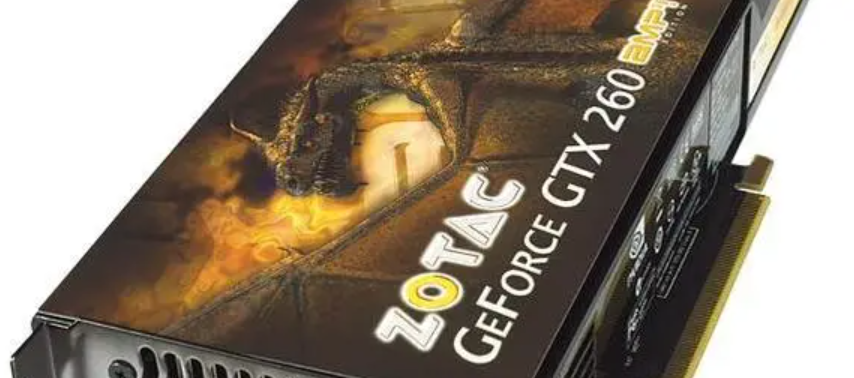Introducing the EVGA GeForce GTX 260 Core 216 Superclocked graphics card! In this review, we’ll take a closer look at this powerful GPU from EVGA. Explore its features, performance, and overall capabilities. Whether you’re a gaming enthusiast or a graphics-intensive user. The GTX 260 Core 216 Superclocked promises to deliver impressive visuals and smooth gameplay. Join us as we delve into this EVGA GeForce GTX 260 Core 216 review and see if it lives up to its reputation. As a reliable and high-performing option for your computing needs.
What is EVGA GeForce GTX 260 Core 216?
The well-known producer of computer components EVGA announced the GeForce GTX 260 Core 216 graphics card. Based on NVIDIA’s GT200 GPU architecture, the GTX 260 Core 216 has better performance. It has better functionality than the normal GTX 260 model.
In Depth Details about All Aspects of EVGA GeForce GTX 260 Core 216
Image credit – ebay
A thorough and in-depth analysis of the Nvidia GeForce GTX 260 Core 216 graphics card is provided below:
Architectural and Specifications
The NVIDIA GT200 GPU architecture, which was unveiled in 2008. Serves as the foundation for the EVGA GeForce GTX 260 Core 216. It has 216 CUDA cores, handles parallel processing tasks and speeds up computationally heavy functions like rendering and image processing. The GTX 260 Core 216 has a core clock speed of 576 MHz and a shader clock speed of 1242 MHz.
The GTX 260 Core 216 has 896MB of GDDR3 video memory with a 448-bit memory interface as part of its memory configuration. The clock speed of the RAM is 1998 MHz. Large data sets can be handled effectively and textures may be rendered smoothly thanks to high memory bandwidth and capacity.
Performance
The Nvidia GeForce GTX 260 Core 216 had competitive performance. When it was first introduced in the mid-range graphics card market. It was able to run well-known games from the period at moderate to high settings and frame rates. However, because of age, the card could have trouble delivering fluid gameplay in more difficult and visually demanding contemporary titles.
The GTX 260 Core 216’s capacity to effectively perform graphics rendering. Also processing duties were facilitated by the 216 CUDA cores and the card’s overall design. As a result, it was appropriate for activities like video editing, 3D modelling, and other multimedia applications.
Features and Technologies
Although the GTX 260 Core 216 may not include the most current graphics cards’ cutting-edge capabilities. It nonetheless provided several important technologies at the time:
1. CUDA technology: The card utilised NVIDIA’s CUDA technology. It makes use of the GPU’s parallel processing capability to speed up a variety of computational workloads. Scientific simulations, video transcoding, and other computationally intensive tasks might all be done more quickly thanks to CUDA technology.
2. Support for PhysX: The GTX 260 Core 216 also had PhysX support, which improved in-game physics simulations. With the use of this technology, PhysX-compatible video games may now include realistic effects. That includes dynamic particle systems, lifelike character animations, and accurate simulations of fluids and clothing.
3. The Scalable Link Interface (SLI) Support: Users were able to join several GTX 260 Core 216 graphics cards in a SLI configuration. Since the graphics card was compatible with NVIDIA’s SLI technology. By using the power of many GPUs, this allowed for improved performance and graphics capabilities.
Power and Cooling
The Nvidia GeForce GTX 260 Core 216 used a variety of cooling techniques to guarantee the best possible thermal performance. They combined fans, heat sinks, and cutting-edge heat pipe technology. Due to the effective heat dissipation provided by these cooling methods. The card was able to operate at stable temperatures even while under a lot of stress.
The GTX 260 Core 216 needed power, and it got some of it via the PCI Express x16 slot. But it also needed electricity from two 6-pin PCIe power connections. It is crucial to confirm that the system’s power supply unit can handle these power requirements.
Connectivity and Outputs
The Nvidia GeForce GTX 260 Core 216 had a variety of outputs to support various display configurations. VGA, HDMI, and dual-link DVI-I outputs were all available. While the HDMI output allowed for high-definition audio and video transmission to compatible screens. The dual-link DVI-I outputs offered higher resolution displays and permitted digital connections. Older monitors and screens were compatible with the VGA output.
Software and Driver Support
Software utilities and driver support were
supplied for the GTX 260 Core 216 by EVGA. Users were able to optimise performance, get access to extra features. Make sure that the newest games and programmes were compatible. Thanks to the graphics card’s interoperability with NVIDIA’s graphics drivers. EVGA could have furthermore provided its own software tools to manage and keep an eye on the settings of the card.
Price and Availability
The Nvidia GeForce GTX 260 Core 216 graphics card is an outdated model. Thus it is probably no longer offered for new purchases. However, it could be accessible via third-party vendors or as a used or refurbished alternative on certain markets. The cost of the card will vary depending on the card’s condition, demand, and accessibility to newer substitutes.
Frequently asked questions
Can the EVGA GeForce GTX 260 Core 216 run contemporary games?
A1: Although the GTX 260 Core 216 was capable of running well-known games from its day. It could have trouble with contemporary games owing to its obsolete architecture and constrained VRAM.
Does the EVGA GeForce GTX 260 Core 216 support DirectX 11 or higher?
A2: No, the GTX 260 Core 216 does not support newer DirectX capabilities. Also graphics improvements available in more current games since it only supports DirectX 10.
Can I edit videos or create 3D models with the EVGA GeForce GTX 260 Core 216?
A3: Thanks to its CUDA cores and processing power. The GTX 260 Core 216 can handle video editing and 3D modelling work fine. However, a more recent and potent graphics card would be advised for jobs that need more work.
Can I use more than one monitor with the EVGA GeForce GTX 260 Core 216?
A4: The dual-link DVI-I, HDMI, and VGA outputs of the GTX 260 Core 216 enable multiple displays. Enabling multi-monitor configurations and expanded desktops.
Do you still have the EVGA GeForce GTX 260 Core 216 in stock?
A5: The GTX 260 Core 216 is not likely to be made available as a new product as it is a rather old graphics card. It may still be purchased, used or refurbished, however for greater performance and compatibility. It is advised to look into newer graphics card choices.
Conclusion
Finally, at the end of the Nvidia GeForce GTX 260 Core 216 review, we’ve got to know that. Even though the EVGA GeForce GTX 260 Core 216 was a spectacular graphics card at the time. It is now seen as being out of date. Although it included CUDA and PhysX and offered good gaming performance, developments in graphics technology have put it behind. Modern graphics cards have better speed, power economy, and support for cutting-edge technologies like ray tracing. Investigating newer graphics card possibilities might be a more sensible decision. If you’re seeking the best gaming experiences and compatibility with the most recent software. However, for those who want to relive their favourite gaming moments from the past. The GTX 260 Core 216 still retains a special place in their hearts.








